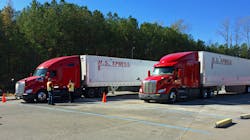Truck drivers hope for continued efficiency post-COVID-19
This year has changed exponentially since the novel coronavirus entered the country. What started out with stampedes for toilet paper has since escalated to civil unrest and protests for change.
In a webinar hosted by U.S. Xpress on June 18, four U.S. Xpress drivers shared their experiences on the road since the start of the pandemic in March. Here's a snapshot of those experiences.
Wayne Roy and Erin Evans, a driving team that has been on the road since the beginning of the pandemic, had a hard time getting PPE [personal protective equipment] at first.
“We eventually got PPE at truck stops after a few months,” said Roy. “Customers were giving us temperature checks upon arrival. They were even limiting the amount of trucks at a time to deliver, which made the process take a lot longer.”
Jerry Martin said there were a lot of delays at first. “I’d deliver to Walmart, and there’d be 30 to 40 trucks waiting to get in, but now it’s all on the fast track.”
Evans confirmed that wait times, at the beginning, were hours long for drivers, but “customers like Proctor and Gamble got their process together very quickly.”
Martin emphasized that the technological advancements companies have been forced to make since the start of the pandemic are exactly what the trucking industry has been thirsty for.
“One of my customers, Nestlé Water, is way more efficient now,” Martin continued. “Getting in and getting out with their digital system gives you all the information you need within minutes. A process that used to be 15 to 20 minutes is now two to three minutes from getting the info to getting the trailer.”
Even drivers' relationships with their fleet managers have improved during the pandemic.
“The new workflows are working much better for me in relation to my fleet manager,” said driver Christopher Elliot. “Revenues are up.”
Martin added that his “fleet manager is more relaxed now, which makes for a much better experience.”
When remarking on how lifestyles have changed on the road, Martin said that he doesn’t “eat much from truck stops; there are too many people around. Despite that, people have been very nice on the road. For example, a random stranger at the El Campo, Texas, Walmart paid for my food one day. It’s very clear that drivers aren’t an afterthought anymore.”
“People are nicer,” Evans added. “They are more patient because they’re dealing with the same issues we are. Truck stops are cleaner, safer and brighter than they’ve ever been before.”
Just as pandemic routines were getting to become second nature, the country turned into chaos as hundreds of thousands took to the streets to protest the death of George Floyd, an unarmed Black man killed by police in Minneapolis, bringing a newfound danger and worry to life on the road.
“In LA, the strategy was to pick up loads early while it was still peaceful on the roads,” Roy explained. “It’s important to listen to the alerts on your CB radio station. For example, we heard one alert that people were throwing bricks over the overpasses onto oncoming traffic on a particular highway. So, we avoided that and took back roads. Even though it took us longer, it kept us safe. When you see things on the road, put the alert on the CB so other drivers are alerted as well.”
“You didn’t know where the riots were,” added Evans. “Because going into LA was very unsafe, we decided to go home for the first time since March to wait until it was safe on the road.”
Webinar moderator Matt Herndon, chief operating officer at U.S. Xpress, explained that people were going to the unloading docks of businesses waiting to get product directly off of the truck, bringing a legitimate fear of getting robbed when making deliveries.
“Walmart is one of my safest customers,” Martin said. “Individual customers were very guarded and cautious at the beginning, but luckily now it’s been more pleasant. Mentors were warning to be careful and safe and to always park in a good area.
“It was a very dangerous situation when there were a lot of people on the freeways," he continued. "There was extra police presence, which caused me to find detours to make deliveries.”
During these high-stress situations, support systems at home have been vital to these drivers.
“My mom is a proud warrior,” Martin said. “She’s prayed for me every day while I’m on the road. My wife, on the other hand, she is nervous every day. She makes me take my clothes off in the garage and put them in a bag. No hugs, no kisses until I’m showered and disinfected.”
“My parents are immunocompromised,” Evans said. “So, we just stayed on the road to keep them safe. They watched the news at home and warned us of anything going on in the country, whether we were headed into a potentially dangerous county or if the weather was going to be bad.”
Drivers shared the biggest lessons they’ve learned since the start of the pandemic:
- Evans: “Definitely the safety aspect – being more aware on the road as well as the cleanliness. Don’t be a part of the problem – be a part of the solution.”
- Roy: “Use the CB in a positive way by communicating with each other.”
- Elliot: “Customers are more driver friendly now, providing us with PPE and sanitizer. That should definitely continue.”
- Martin: “We need more of the same, but more technology, more solutions, more communication. We were forced to do it at first, but let’s keep it up.”
About the Author
Catharine Conway
Digital Editor
Catharine Conway is a past FleetOwner digital editor who wrote for the publication from 2018 to 2022.

